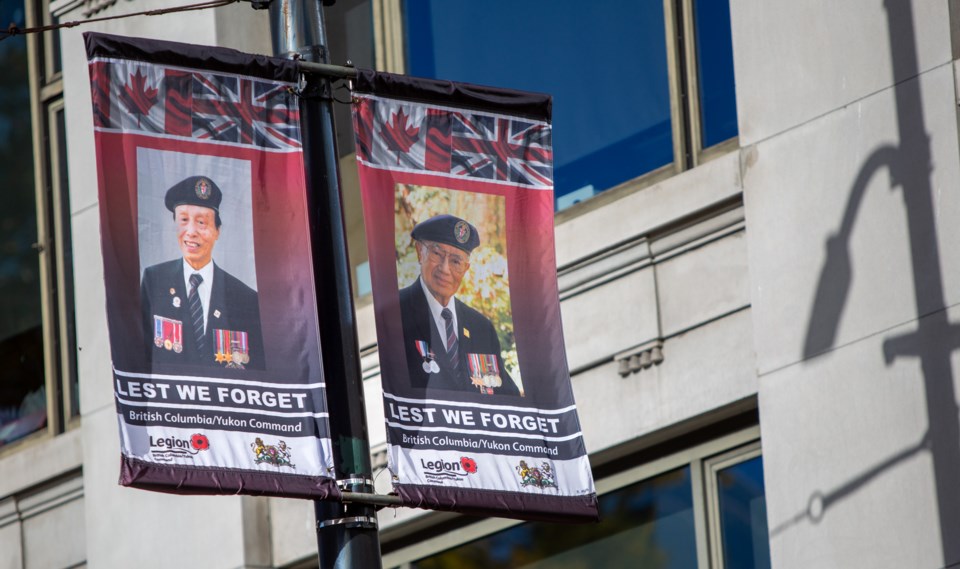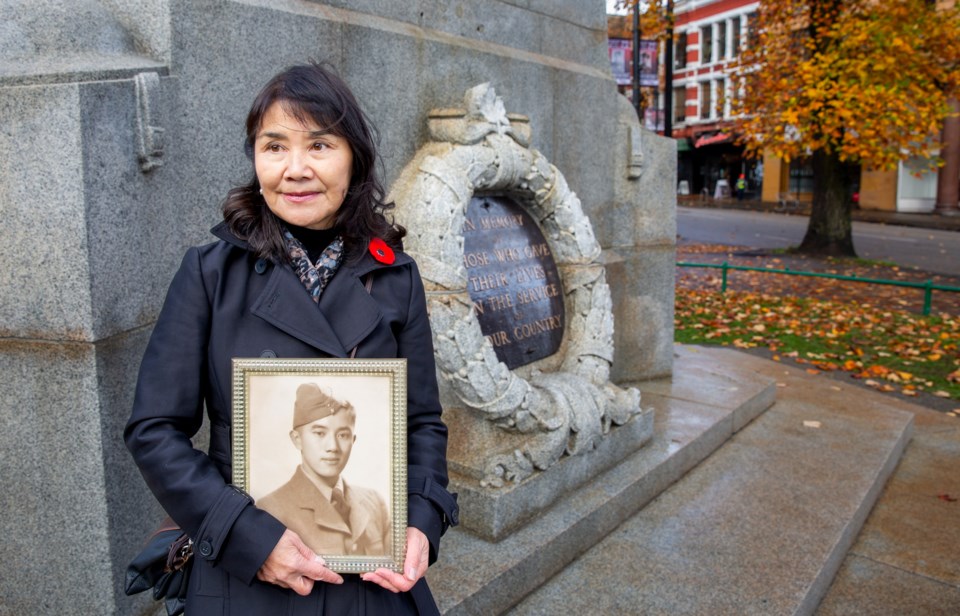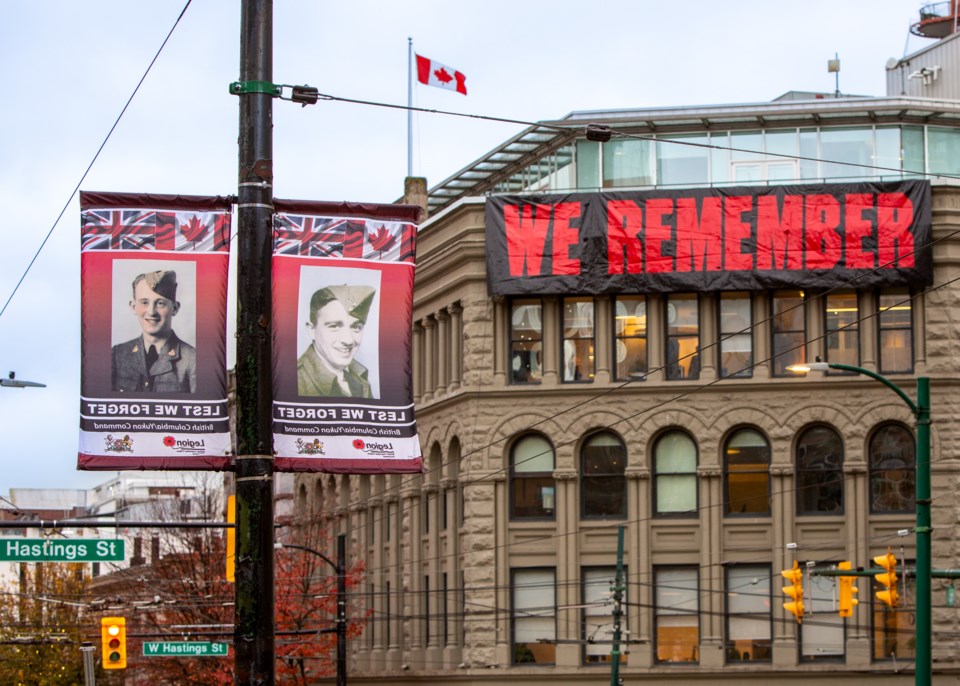Look up.
Watch where you’re walking, or driving, but look up when you cross the Georgia and Dunsmuir viaducts.
Do the same when you enter Chinatown via Main Street or while on your way to Victory Square along West Pender Street for the Remembrance Day ceremony.
The recommendation is from Bob Underhill, chair of Vancouver’s Remembrance Day committee and one of the people responsible for developing a banner program that features faces of more than 200 veterans on city light poles.
“I'm really proud that we were able to accomplish this,” said Underhill, whose biological father and adopted father are both represented. “It really ties the community to those who paid the ultimate sacrifice in a lot of cases, and those who have served and who are still serving. I think it's important.”
The “we” in this case includes the Royal Canadian Legion's BC/Yukon Command, ANAVETS Pacific Unit #280 BC Command and the Chinese-Canadian Military Museum, which worked with Flying Colours International in Port Coquitlam to develop the banners.
Money raised via veterans’ families, corporate donors and individual donations from community members made it possible to produce duplicates of each veteran’s photograph, resulting in 456 banners.
Male and female veterans from the First World War, Second World War, Korea, Afghanistan and other global conflicts are represented on the banners. They have been up since the first week of October and will come down at the end of November.
The idea for the program is an extension of what Legion branch #177 in Mount Pleasant began a few years ago, when it featured veterans on banners along a stretch of Main Street.
With this year being the 100th anniversary of the Victory Square cenotaph, Legion members wanted to expand the program to include areas of Chinatown, downtown and other streets in the city, including West Georgia to Stanley Park.
The Legion reached out to ANAVETS Pacific Unit #280 to get involved, which led to the involvement of the Chinese-Canadian Military Museum, resulting in 52 Chinese-Canadian veterans recognized on the banners.

'Fantastic idea'
Frank Wong is one of those veterans.
His banner appears on West Pender Street near Victory Square. Another one hangs on Main Street, near Prior Street.
His daughter, Teresa Mew, said her father was one of the founders of the Chinese-Canadian Military Museum. After Wong died at 94 in 2013, Mew wanted to keep her father’s legacy alive and volunteered with the museum, which is located in Chinatown.
She is now vice-president and treasurer.
“I thought it was a fantastic idea,” she said of the banner program.
She went to work to contact families of veterans and supporters of the museum. Of the 52 banners, 27 were paid for by families, with community members such as Carol Lee and Mayor Ken Sim donating additional funds to sponsor banners.
London Drugs, Onni Group, Beedie, PCI Developments and the Albert Silver family were other contributors, which ensured veterans without families were recognized on the banners.
The City of Vancouver also waived $15,000 in fees associated to renting the light poles.
'So many people dead'
Wong, who was born in Vancouver, joined the Canadian Forces when he was 22.
He was assigned to a mobile repair unit that landed on Juno Beach in France one month after the D-Day invasion on June 6, 1944.
His unit’s job involved repairing heavy artillery and vehicles.
On the “Heroes Remember” section of the Government of Canada’s website, Wong shared his experience of serving in France, recounting that Juno Beach and the area was still under enemy fire.
One night, he dug a foxhole in a field, where he sought cover.
“[The German planes] came over at night to try to bomb the beachhead,” he said.
“When you see the planes going over and the guns going off…I remember saying the Lord’s Prayer about a million times to keep my nerve up. I’d look up and I see some of my friends, they were mumbling, too. I think they were doing the same thing.”
What he experienced days later in the obliterated city of Caen was horrific.
“I remember there were so many dead people around,” he said. “I got sick that day because when we went in there, the smell was so bad that I vomited. That's the only time I ever vomited. The smell was just out of this world, there was so many people dead.”
Wong pushed on through France and participated in the liberation of Holland.

'Right to vote'
For Mew, what was significant about her father’s service was that he joined the Canadian Forces at a time when he was not allowed to vote because he was Chinese — even though he was born in Vancouver.
“My father felt that if he joined the army, he might have more opportunities in the future,” she said. “He also joined with the hope that it would show his loyalty to Canada and that at the end of the war, the Chinese would get the right to vote. That was really important to him.”
In 1949, Chinese-Canadians voted in the federal election.
Fast forward to 2024, and while laws such as the Chinese Immigration Act were repealed a long time ago and Chinese-Canadians enjoy the same freedoms as all Canadians, anti-Asian racism was rampant during the pandemic.
Police still report hate-themed incidents.
Mew said her father would have been disappointed to learn of such hate.
“When people were targeting Chinese and Chinatown with graffiti and hate crimes and saying derogatory things to Chinese, I think my father would have been horrified,” she said. “My father felt that he was a Canadian and born here and belongs here, and why are people being targeted because they are Chinese?”
Mew is hopeful the banner program will educate people about Chinese-Canadian history.
“Look up at the sea of faces who sacrificed their lives for our freedoms, and to be appreciative and to remember what they've done,” she said. “I think over time people forget, or they don't know the story, and it's easy to take things for granted.”
Added Mew: “There were horrific things that happened during war, and maybe we can learn some things to try to prevent it from happening again. And there's still a lot of work we need to do, as far as with racism and discrimination.”
'We want to see our grandpa'
King Wan, president of ANAVETS Pacific Unit #280, said he hopes the banner program will continue to expand and feature more veterans in future years. Wan is considering the idea of making the banners interactive next year — perhaps with a QR code — or implementing another way for people to learn about the veterans.
“At this stage, it’s still a little bit fuzzy, but we’re working between now and the next little while to have all of the names and backgrounds documented on some sort of website, and when that happens, we'll try to share that with everybody,” Wan said.
Julia Izadi of Flying Colours International said the company has manufactured and printed street banners for the City of Vancouver for 15 years. Izadi said Flying Colours was proud to be part of a project that features veterans.
“This is sentimental and a heartwarming program, unlike anything else,” she said.
“Of course, events that come to Vancouver like Cirque de Soleil and Grey Cup are wonderful, but this is really a personal project. People who have purchased these banners have since been in touch with us to know where they can find their banner. ‘We want to see our grandpa, want to see our dad.’ So, there's a real heart warmth to this.”
Note: The original cutline for the banner photograph of veteran Frank Wong mistakenly identified the name of the other veteran to his right. His name is Edward Lee. Glacier Media apologizes for the error.



